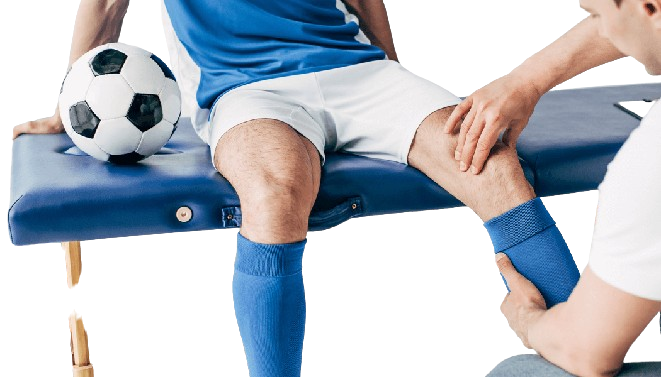Sports injury rehabilitation Expert in Perumbakkam
Your Trusted Partner in Sports injury rehabilitation
Sports injuries are common and can occur throughout your body to bones, muscles, tendons, ligaments and other structures.We are here to provide you with top-notch care and guidance to tackle your problems.

Understanding Sports injury rehabilitation
Introduction
Rehabilitation is the restoration of optimal form (anatomy) and function (physiology).
Musculoskeletal injuries can have immediate and significant detrimental effects on function. When an individual experiences or is likely to experience limitations in everyday functioning due to ageing or a health condition, including chronic diseases or disorders, injuries or traumas, a set of interventions is needed. “Rehabilitation enables individuals of all ages to maintain or return to their daily life activities, fulfill meaningful life roles and maximize their well-being”.
The noun rehabilitation comes from the Latin prefix re-, meaning “again” and habitare, meaning “make fit”. It is important to identify rehabilitation as a process targeted at minimising the loss associated with acute injury or chronic disease, to promote recovery, and to maximise functional capacity, fitness and performance.
Recreational physical activities and competitive athletics account for a significant number of injuries. Musculoskeletal injuries are therefore an inevitable result of sport participation. Football has the highest incidence of catastrophic injuries, with gymnastics and ice hockey close behind. Tissue injury from sports can be classified as macro-traumatic and micro-traumatic.
What are the benefits of Sports Injury Rehab?
Our specialist musculoskeletal physiotherapists will work with you to provide a thorough rehabilitation programme which will encourage a number of benefits including:
- Restoring full function as soon as possible
- A faster recovery and return to sport
- Strengthening weakened muscle groups
- Reducing any pain and inflammation from your injury
- Maintaining cardiovascular fitness whilst you are out of sport
- Minimising the risk of future injuries
- Improving your flexibility and coordination
- Advice on correct footwear and equipment
Who will benefit from Sports Injury Rehab?
Whether you have been injured whilst playing high level sport or during recreational activity, the physiotherapists at Physio.co.uk will be able to design you a full rehabilitation programme to help you get back to full fitness. Our physiotherapists have a vast amount of experience in treating a wide variety of sports injuries including:
- Recent or chronic injuries
- Anterior cruciate ligament (ACL) rupturesor tears in the knee
- Shoulder Dislocation or separation
- Rotater cuff injuries
- Frozen shoulder injuries
- Stress fractures
- Pulled Hamstrings
How does Sports Injury Rehabilitation help?
Your rehabilitation programme designed by our dedicated musculoskeletal team will improve your recovery in the following ways:
- Breaking down scar tissue and promote the healing of tissues
- stretching muscles and ligaments to increase range of movement
- Relieve any muscle spasm or stiffness
- Increasing lubrication and nutrition of injured and unaffected joints
- Removes chemicals in the injured area that are causing pain
- Builds up weakened muscles to regain full function
Sports Injury Rehabilitation Treatment
Proprioceptive training: This type of training is used to help athletes regain control over their body movements and awareness. It’s particularly important after joint injuries.
What are the most common parts of the body injured?
Sports injuries can affect any part of your body. They most often affect:
- Achilles tendon: The Achilles tendon is a thick cord that connects the back of your lower leg (calf) to your heel. It helps you walk. But the tendon can become swollen, inflamed and stiff. It can even tear. This is called Achilles Tendinites or Achilles tendon rupture
- Ankle: Your leg and foot join together at your ankle. It contains three joints, as well as several bones, cartilage, ligaments, muscles and tendons.Ankle pain is often caused by a sprained ankle.
- Elbow: Your elbow is the joint that acts as a hinge between your upper and lower arm. People often experience pain in their elbow from repeat motions and overuse (for example, tennis elbow and Little League elbow).
- Head: Your head includes your face, skull and brain. One of the most common head injuries is concussion.
- Knee: Your knee is a complex joint that acts as a hinge between your thigh and lower leg. It contains bones, cartilage, ligaments and tendons. knee pain can be caused by jumpers knee or runners knee. Other common injuries include meniscus tear and anterior cruciate ligament(ACL)tear
- Shoulder: Your shoulder connects your upper arm to the trunk of your body. It contains your rotator cuff, a group of muscles and tendons that keep the upper arm in your shoulder socket. Rotator cuff tendinitis and rotator cuff tears are common sports injuries.
What causes sports Injuries?
Sports injuries have many causes, including:
- Accidents, such as a fall.
- Bad habits with exercise, such as not warming up or stretching enough.
- Lack of safety equipment, or gear that’s damaged or worn incorrectly.
- Shoes that don’t fit well or provide enough support.
- Sudden start to an exercise program or significant increase in physical activity that your body isn’t used to.
What are the symptoms of a sports Injury?
The signs and symptoms of a sports injury depend on the type of injury. Common symptoms include:
- Aches, pain or tenderness.
- Bruising.
- Deformity, such as a bone or joint looking out of place.
- Decreased range of motion.
- Grinding, cracking, clicking or popping noise.
- Inability to bear weight on your hip, leg or foot.
- Skin that’s warm to the touch.
- Stiffness or weakness.
- Swelling.
- Trouble moving a body part normally (for example, you can’t move it as far or it locks up when you try to move).
Frequently Asked Question on sports Injury
Return-to-play decisions should be made in consultation with healthcare professionals. It often involves a gradual progression of activities, monitored by physical therapists or sports medicine specialists.
